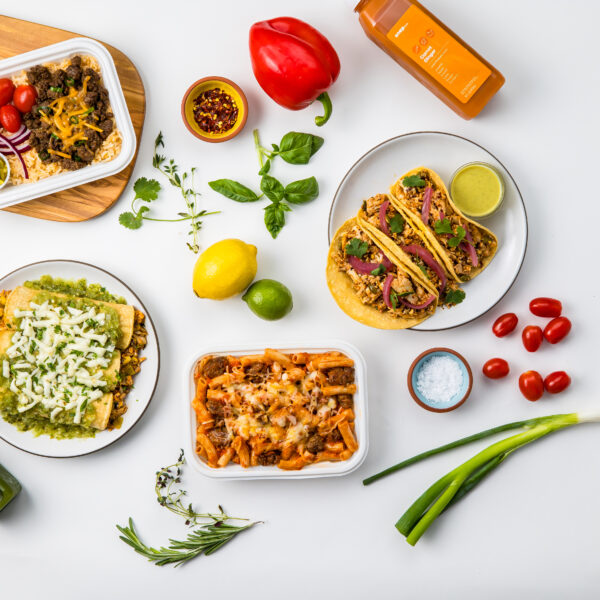You’ve probably heard the term, “cured meat” before, but do you know what it actually is? If not, we’re here to give you the scoop! From the exact definition of cured meat to elaborating on the differences between cured and uncured meats to exploring different kinds of cured meat, this blog will cover all the bases, and probably make you hungry for a decadent charcuterie board. Let’s get started!
What is cured meat?
First, let’s clarify exactly what curing is — curing is the process of adding some combination of salt, sugar, nitrites, and/or nitrates to meat to preserve flavor and color. There are two major types of curing processes; a wet process and a dry one.
The wet process can also be referred to as brining or pickle curing — depending on what additives are used — and is done by submerging the meat into a wet brine or injecting the brine directly into the meat. Dry curing, on the other hand, simply involves rubbing the salt mix into the meat.
The goal of any curing process is to slow spoilage and prevent the growth of microorganisms.
Healthy Hint: Don’t fear nitrites and/or nitrates! In fact, a new study shows that nitrites are beneficial for immune and cardiovascular function! And even if nitrites/nitrates were a risk factor, cured meats do not carry a substantial enough amount to even have an impact on your health.
Cured vs uncured meat
You’ll often hear about the cured vs uncured meat debate in relation to one of the world’s most favorite meats: bacon. But, what does it actually mean when you see the word “uncured” on a label, and is it really healthier for you?
The short answer to the above question is no, uncured meat is no healthier for you than cured meat. In fact, uncured meat is still cured, it’s just done so with different sources of nitrites.
Let us explain…
When uncured meat isn’t cured with sodium nitrites/nitrates, it will be cured instead with a form of celery — or beets, or some other vegetable naturally high in nitrates — which contain natural and unregulated amounts of nitrites. So, there may not be any nitrites added>, but that doesn’t mean that plenty of naturally occurring nitrites are not present in your uncured meats, because there are.
Basically, the bottom line to the question, “what’s the difference between cured and uncured meat”, is that while cured and uncured meats receive their nitrites/nitrates from different sources, these chemical compounds will be present in all your favorite meats regardless of what the package says.
Healthy Hint: Understand that neither nitrates or nitrites accumulate in the body. 55% of nitrites will be excreted into your urine after five hours of ingestion and any nitrate that is absorbed has a very short half-life and will disappear from your blood in under five minutes.
10 common types of cured meats
If you’ve indulged in a charcuterie board or two, got a hoagie from your local deli, or made bacon for breakfast, then you’ve probably had a taste of some of the most common cured meats
Prosciutto
Made from the whole hind leg of a pig, it is an Italian-style cured meat. This is often a go-to addition to anyone’s charcuterie board.
Bacon
You definitely saw this one coming… bacon! Bacon is often cured and smoked, but be sure to cook it for a sufficient amount of time, as it isn’t cured long enough to kill all the bacteria.
Pepperoni
Made of finely ground beef and pork, pepperoni is another wildly popular Italian-American cured meat.
Pancetta
Similar to bacon, pancetta is a cured meat made from the pork belly, though it is not smoked.
Pastrami
Many people’s deli staple, made from cured beef, the pastrami is cured through a brining process, followed by drying and smoking.
Capocolla
Capocolla is a delicious pork-shoulder meat that is often seasoned with red wine and garlic before it is salt-cured and air-dried.
Bologna
We’re talking traditional bologna, not the pink stuff you find at the grocery store. Authentic bologna will be made with pork and is often heavily seasoned.
Lap Cheong
If you’re familiar with Asian cuisine, particularly Chinese cuisine, then you may have heard of Lap Cheong before – a slightly sweet sausage with a hint of 5-spice.
Soppressata
Soppressata is a popular Italian sausage that, like many other types of sausage, is made from cured ground meat.
Andouille
This sausage is originally from France and has evolved to become one of the most popular sausages in the States.
Your takeaway
Just to recap, cured meat is an extremely common and age-old process of preserving a meat’s flavor and coloring, and even when meat is labeled as “uncured” it has still been cured by using a vegetable or fruit with a high amount of naturally occurring nitrites. Don’t fear nitrites/nitrates and enjoy bacon, sausage, and these delicious cured charcuterie meats on occasion. And for a wide variety of fresh meats, check out our favorite protein-packed Snap dishes.





Leave a Reply
No Comments